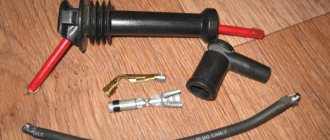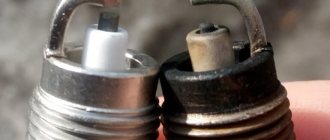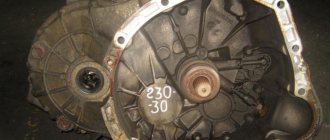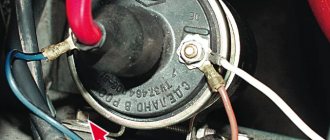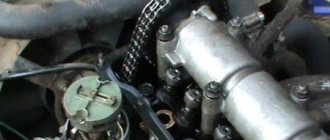September 16, 2018
In general, replacing spark plugs yourself is not difficult, but you need to know exactly how to carry out this procedure. The article will be useful, first of all, for car enthusiasts without experience in vehicle maintenance.
Spark plugs in a car are used to ignite the fuel-air mixture in a heat engine. Damage to the spark plugs causes the mixture to ignite worse, the engine loses its power, ignites and detonates. Detonation is the untimely or spontaneous ignition of the mixture in the combustion chamber, accompanied by popping sounds and the appearance of a shock wave. Gradually, the combustion chamber becomes clogged and becomes covered with soot and combustion products of the mixture. As a result, the engine as a whole wears out.
Description of the location of the car's spark plugs
They are located in the so-called spark plug well, mounted in the cylinder block.
On one side, the spark plug is connected to the high voltage ignition conductor. This part may be located above the cylinder block or hidden in the spark plug well. The opposite end of the spark plug is located directly in the combustion chamber. At the right moment, an electric current arises on the electrodes, which, with the help of a spark, ignites the mixture.
The spark plug has a central electrode or may use several side conductors. The system works thanks to the distance between the central and side electrodes. This ensures sufficient operating power and spark constancy. Due to the generation of current, soot forms on the electrodes, which prevents the passage of the spark. And the electrodes themselves wear out due to intense work.
A longer service life is provided by candles with elements made of platinum or iridium. They produce less soot. Cleaning them with rags or brushes is not recommended at all, but ordinary candles need to be wiped with a dry rag or even cleaned with a wire brush, depending on the situation.
Additional recommendations
To avoid various troubles in the future, you should follow a few simple recommendations:
- spark plugs need to be changed not individually, but as a whole set;
- To prevent dirt from getting into the spark plug hole, wash the engine before replacing;
- high-voltage wires also need to be replaced as a set;
- when tightening spark plugs, you need to select the correct tightening torque;
- The spark plug connector seal should fit tightly around the spark plug.
Features of replacing spark plugs
A weak tightening torque will result in insufficient heat dissipation. Well, if the torque is too high, the likelihood of damage to the new spark plug will increase. The table below provides recommendations for tightening different types of spark plugs.
Spark plug tightening torque
Table. Spark plug tightening torques.
| Spark plug thread diameter | Recommended tightening torque |
| M8x1.00 | 8-10 Nm |
| M9x1.00 | 8-10 Nm |
| M10x1.00 | 10-12 Nm |
| M10x1.25 | 10-12 Nm |
| M12x1.25 | 15-20 Nm |
| M14x1.25 | 20-25 Nm |
| M18x1.5 | 30-40 Nm |
Manufacturers often provide all the necessary information about tightening torques on the packaging. But if these values are not available, then you can always use our tips.
Required Tools
It is unlikely that it will be possible to replace spark plugs without the necessary tools. Let's figure out what we need for work.
First of all, this is a spark plug wrench, a specialized tool for removing and tightening spark plugs. Since the size of spark plugs is different for different cars, the spark plug wrench also needs to be selected. The most commonly used tool is for candles with a diameter of 16 mm, but there are exceptions. Take the time to check the features of your specific vehicle. We recommend buying a spark plug wrench with a rubber seal inside. This makes it easier to remove the candles and prevents them from falling.
In addition to the spark plug wrench, you will need a flat-head screwdriver. With its help, you can open the block cover and pry off the conductors suitable for the spark plugs.
Depending on the type of vehicle you have, socket bits may be required. Well, at the end of the list of necessary items are the spark plugs that will be required for replacement. Of course, the tool kit for your vehicle may be slightly different. However, we offer a more or less universal set for replacing spark plugs.
Installation of new products
Today, as a rule, the following types of candles are presented in sales:
- Platinum products.
- Iridium products.
- Yttrium products.
Types of spark plugs
It is very important to replace the spark plugs correctly. There are many combinations and parameters. Their price range: 200 – 800 rubles. The materials used are different. Versions made from precious metals are much more expensive than versions made from standard materials. Reason: such coatings are much more resistant to wear. If you have any doubts about the choice of candles, contact the seller for advice.
It is advisable to purchase candles with parameters and threads similar to those of the products being replaced. You should not purchase candles with smaller parameters. The manufacturer specifically specified these dimensions. And stick to these values. Consulting with a specialist will help you make sure that the chosen option is correct. Don't be lazy to spend a few minutes on this. Otherwise, you will soon have to solve new dilemmas.
As a rule, spark plugs are purchased whose gap is fixed or adjustable. If you need to constantly check your candles and make some adjustments to them, you should opt for the second option. With this choice, you will get controlled contacts. First, make sure that the gap is optimal for your car. To do this, you need to carry out an independent check: the candles are taken out of the packaging, checked, and this parameter is measured.
How to understand when it's time to replace spark plugs
The fact that the spark plugs require replacement or cleaning of carbon deposits is eloquently indicated by engine malfunction.
- He starts to trip. That is, the operation of one or more cylinders is disrupted
- Noticeable drop in engine thrust and power
- Difficulty starting the internal combustion engine. The starter is clearly working, but starting does not occur.
- An increase in the amount of carbon monoxide in the exhaust, it itself turns black
- The appearance of detonation (we already wrote about this at the beginning of the article)
The listed symptoms appear individually or in combination. Please note that replacing spark plugs with a service life of less than 10,000 km does not make sense. To restore operation, it will be enough to clean them of carbon deposits and check the contacts.
Electrode gap size
When spark plugs are manufactured, they are marked in a certain way; among other information, such markings can be used to find out the gap standard. Look at the last number in the row of markings (the value is indicated in millimeters) and compare whether the actual spark plug electrode gap corresponds to the indicated value. If the gap exceeds the specified value, the spark plug must be changed urgently.
In some cases, the last digit may be missing from the marking, this indicates that the gap is taken “by default” and should be equal to 0.8 mm.
Nagar
Ideally, during ignition, carbon deposits should not appear on the spark plugs, given that during normal combustion, the electrodes tend to self-clean. In “not ideal” cases, white or, conversely, black soot can be found on the candles, which is by no means a sign of low quality candles. What is most likely happening here is an incorrectly configured ignition, and in this case it is impossible to do without the intervention of a diagnostician. In cases where the candles differ from each other in appearance, for example, there is carbon deposits on one of the candles or the candle is “wet”, rest assured that the candle is worn out and a complete replacement of the set of spark plugs is required. It is the entire set, and not just a separate spark plug with signs of wear.
Type of ceramic insulator
An external inspection of the ceramic insulator can also indicate the degree of wear of the spark plugs. First of all, microcracks filled with brown plaque are detected. Visually, all this looks like a kind of “grid”. This is a clear sign of wear and the entire set of spark plugs should be replaced.
Another common defect is the appearance of a so-called brown “skirt” on the electrode. This effect occurs due to delamination of the spark plug body and the ceramic insulator. As a result, combustion products penetrate into the gap between the layers, which in turn further enhance the already begun delamination of the body, which ultimately leads to the appearance of that very “skirt”. The newly begun formation of delamination cannot yet be considered criminal, but if the “skirt” already looks quite impressive and is dark brown in color, then such a candle should be replaced without delay.
Is it necessary to use only candles recommended by the manufacturer?
Typically, the manufacturer will list specific spark plug manufacturers, as well as their type, in their user manual. However, markings and type systems may vary depending on the manufacturer. Of course, there are also exclusive options, specially created to order from automakers, intended for exclusive car brands. Perhaps these are more exception cases, and most often (about 98% of types) are produced by major manufacturers, and the labeling system may vary, but the candles themselves will be identical.
Of course, this provides car enthusiasts with a certain freedom of choice. You can use candles from any manufacturer, the main thing is that they correspond to the type and heat rating specified in the instructions. It is even possible to install a candle that is superior in quality to its previous analogue, or is a more modern option. For example, instead of “regular” spark plugs, install a more modern model, that is, developed later than the year of manufacture of the car.
We must not forget that the car manufacturer, when completing the final product, adheres to the principle of “necessary sufficiency”. This means that he will not install a candle worse than required on the car, but at the same time, the option of installing a better model is also rejected due to its high cost. That is why the process of selecting the type of candle seems to be quite creative, because it can only be limited by your financial capabilities.
Replacing spark plugs yourself
Let's move on to a direct description of the procedure. The work of replacing spark plugs is carried out only on a cooled engine; it is prohibited to perform the procedure “hot”!
- So, turn off the engine and let it cool.
- Next, clean the top of the cylinder block to remove debris and dust from getting inside the engine.
- Disconnect the current-carrying conductors from the spark plugs. To do this, pull them, turning them slightly in different directions.
- Remove the spark plugs using a special wrench or a ratchet with a spark plug head.
- Inspect the spark plugs and, if necessary, replace them. Let us repeat that sometimes it is enough to simply clean them with a brush or dry cloth.
Before screwing in a new set of spark plugs, be sure to wipe them with a dry cloth too. We are pursuing the same goal - avoiding debris getting into the engine. We do not recommend coating new spark plugs with oil. In this case, it will burn in the candle block. This will lead to nothing but damage to the spark plugs and engine. If the spark plugs are tight when screwed in, with resistance, then it is better to carefully unscrew them and try to screw them in again. It's possible that you just missed the thread. It is better to start tightening it gently, by hand, so as not to damage the threads for the candles. It is also better to pull with the key carefully.
Installing new spark plugs
Before installation, be sure to visually compare the old spark plug and the new element. They must match. The size of the thread on the spark plug and its pitch must also be identical, as well as the gaps on the ignition elements. Lubricate the threads with a small amount of lubricant, but do not get it on the electrodes themselves, as this may damage the performance of the spark plug. After this, twist the element clockwise by hand until you have enough strength. Use a wrench to tighten, but do not overtighten, as this can also damage the spark plug. Make sure that the washer on the spark plug is below the level of the head on the engine.
After installing the spark plugs, attach the previously removed high-voltage wires to them. The caps should fit tightly. To make sure of this, pull the wire towards you. It should not easily jump off the installed spark plug. After completing the procedure with one, repeat it with the rest of the candles.
Every car enthusiast can carry out the procedure for replacing spark plugs, but if you are not confident in your abilities, any service station will readily undertake this, so the choice is yours - change it yourself or trust a car mechanic.
Why does black carbon appear on candles?
Beginning car enthusiasts, when visually inspecting spark plugs, sometimes notice black carbon deposits, what could this mean? If the soot on the electrode and threads is greasy and oily, this indicates that a lot of oil is getting into the cylinders.
The reason for this: poor condition of valve stem seals, piston rings or valve bushings. Some of the oil breaks through due to wear of the above parts. In this case, candles are not the cause, but an indicator of the problem. The candles are to blame if the soot is dry and black. It is possible that the spark is weak or compression.
If there is a velvety carbon deposit, check the pressure inside the cylinders.
In old-style gasoline engines, black carbon deposits indicate a malfunctioning carburetor. Inventory type engines thus indicate improper operation of the fuel pressure regulator. Additional reasons: over-rich mixture or clogged air filter. Do not forget, also, to replace it every 10,000 km.
Main defects of spark plugs
Everything is fine if:
- Thread 1 is completely dry, not wet.
- Rim 2 - has a dark color and a thin layer of soot or soot.
- The color of the electrodes 3, 4 and insulator 5 can be from whitish, light gray, light yellow to light brown.
You can find out about the malfunction by:
- Wet thread, it can be in gasoline or oil.
- The rim is covered with black, spotted, loose soot.
- The electrodes and insulator, if their color is dark brown with spots, sometimes a yellow spot appears on the very bend of the side electrode.
If the spark plug is not installed hermetically, then dark rims appear on the outside of the metal body and on the insulator. In this case, the spark plug does not work; the rim, insulator cone and electrodes become covered with soot and become wet. Soot deposits can be cleaned with a brush with metal bristles; in cases where mechanical damage and melting are noticeable, the spark plug should be replaced.
Special attention should be paid to the color of the spark plug soot; it can tell a lot about the condition of the engine.
Gap adjustment and diagnostics using a multimeter
When replacing spark plugs, do not forget to adjust their gap. Due to the excessive gap, the spark will begin to disappear, causing the mixture to stop igniting. If the gap on the spark plugs is small, the spark plugs are flooded with gasoline and the ignition coil may burn out.
Checking spark plugs is not necessarily carried out only according to the nature of the engine. The presence of a spark can be checked using a multimeter.
A multimeter helps determine if there is a short circuit inside the spark plug. If there is a short circuit, the spark plug can simply be replaced.
First step
First of all, you need to find out where they are located in the engine.
This is the primary stage. In many 4-cylinder units, the spark elements are located on the side or on top. In 8-cylinder analogues they are positioned on the sides. It is very rare to see such a picture: one part that supplies a spark on each cylinder.
An important condition before the intended work: the engine must be cold.
How to change spark plugs yourself? If you find it difficult to find the parts you need, look for black wires. They are located along the engine. By following them, you can find the details you are looking for.
Read the instructions for your machine. There is the necessary information to carry out this operation.
Spark plug
Frequency of spark plug replacement
If you purchased a car at an official center, then its maintenance work still takes place according to the established technical regulations. Car manufacturers set different mileage intervals for replacing spark plugs. The most common period is between thirty-five and eighty-five thousand kilometers. There is no single clear value for replacement; a lot depends on the operating mode of the engine and the driver himself. The range of values is so large because the candles themselves have different service life. For their production, various technologies and materials are used, which gives different resistance to high temperatures and stress.
Car spark plugs are made of nickel and platinum. The first ones are changed after forty thousand kilometers, and the platinum ones will wait up to seventy thousand kilometers. The quality of iridium-coated spark plugs depends on the thickness of the electrode in the center. In general, this range is from seventy to one hundred and twenty thousand kilometers.
In general, the ideal interval for replacing spark plugs is every twenty thousand kilometers, along with an oil change. Some car owners change the oil more often. Under the operating conditions of the car in Russia, this measure is not useless.
Replacing spark plugs is not a very complicated procedure, but you need to monitor them very carefully, otherwise the engine will suffer and the car will not go anywhere else.
Useful tips on how to replace spark plugs:
These instructions will help you not only complete the replacement process correctly, but also avoid a number of possible mistakes.
- The burnt layer and dirt near the spark plug wells should under no circumstances penetrate into the combustion chamber. Remove dirt before unscrewing spent spark plugs. If dirt gets inside the wells, then do not rely on chance. It is better to blow the dirt out of the chamber using a compressor. You can also start the engine without spark plugs, as a result of which the piston will push out a portion of the fuel mixture along with dirt.
- Do not use random objects, pliers, etc. to unscrew candles. With a special key, it is easier to regulate the force for screwing in the spark plugs, plus they will not fall out thanks to magnets or rubber bands in the spark plug heads.
- Choose the correct tightening force for the spark plugs. If you over-tighten, you will damage the spark plug, and if it is not tightened properly, it will lead to poor heat dissipation. For ease of use, many manufacturers print the required values on candle packages.
It happens that the engine begins to “trouble” immediately after replacing the spark plugs. What can happen?
- A fresh or cleaned spark plug is broken
- During installation, wiring was broken or terminals were damaged.
- The contact between the terminal and the spark plug was broken
- You got confused and connected the spark plug contacts incorrectly.
- Incorrect tightening of several or one spark plug
By changing the spark plugs yourself, you can save a lot, because the price for this procedure at a service station is steep. The most important thing here is not even the experience of replacing spark plugs, but the attentiveness to identify problems in a timely manner. A tip that many people forget about, but which greatly influences the duration of use of spark plugs: use high-quality oil and fuel for your car.
Tags:
- Auto repair shop
Rate the material:
Where to buy quality goods
Experts and drivers with extensive experience advise when answering the question of how often it is necessary to look and change spark plugs
adhere to the manufacturer's recommendations. This is approximately 30,000 km of mileage by car.
“hot” product
, which dishonest businessmen take advantage of. Counterfeit brands are offered everywhere. There is no need to talk about the quality of such a product. Car markets and some small shops on highways and city outskirts are considered a hot spot. Passing motorists buy the product, replace it, and after a short mileage are forced to repeat the replacement operation. This is usually already far from the place of purchase. Therefore, you should purchase goods from time-tested suppliers with an unblemished business reputation. Where can they give a quality guarantee?
In custody
How to check spark plugs yourself
Replacing spark plugs on a Peugeot 308, 408 and 3008
Some motorists may be wondering how long it takes to change spark plugs.
. Among craftsmen there is an understanding of when to replace a spark plug. It is worth remembering that each case is unique and everything is individual.
For some cars, new spark plugs last only 10,000 km, while others use them for up to 100,000 km. To understand what the paradox is, you need to understand what the service life of candles may depend on.
Of course, first of all, the service life depends on the quality of the candles themselves and on the manufacturer. Spark plugs come in the following types:
- Iridium;
- Platinum;
- Regular;
By design, the spark plugs are installed inside the engine, so they cannot be viewed without removing them.
Features of replacement by brand
The above generally describes a standardized procedure for replacing spark plugs, which is typical for all vehicles without exception that run on internal combustion engines. Knowing the basic principles, it will not be difficult to make a replacement on any make of car. Difficulties can arise only when searching for the spark plugs themselves (on some machines, in order to get to the spark plugs, you need to remove and disassemble many obstructive elements), as well as if their location is inconvenient.
For each car, depending on the make, year of manufacture and engine type, strictly defined sections are required. Please refer to the instruction manual for specific markings. It is not permissible to use unsuitable spark plugs on a car. This entails major damage to related elements.
Replacing spark plugs for Volkswagen Polo, Jetta, Passat, Tiguan
The features of engines from the TSI series, which are installed on Volkswagen cars, require the most careful approach. Damage occurs to the rubber tips of the ignition coil.
The manufacturer has provided for the possibility of such breakdowns, so the coil tips are sold separately and replacement will not be so expensive.
To replace the spark plugs, you must remove the pipe. To do this, you need to squeeze the clamp with pliers and move it. Do this at both ends of the pipe, then you can remove it. To prevent contamination, it is better to cover the opening of the open air pipe with a napkin. Then access to all 4 coils will be open.
Next, disconnect the ignition coil plug. There are also some peculiarities here: the lock is tight, if you can’t start it with your hands, you can help with a flat-head screwdriver. Now you can unscrew the bolt securing the coil and remove it. It is not so easy to get it out because the rubber tip gets stuck. If the coil does not reach, you need to loosen it a little. In addition, you can use rounded pliers - slide them under the coil, lift it, clamp it and pull it up, turning it left and right.
Further, the process of replacing spark plugs differs little from the standard version. But before installing the coils in place, it is necessary to lubricate them with high-temperature grease so that there are no further problems with their removal.
In the case of an MPI engine, the spark plugs should be located under the air filter cover.
Replacing spark plugs for Renault Duster, Logan, Sandero
On the Renault Duster 2.0 L F4R there is a small feature that concerns the leftmost coil. The phase regulator valve is attached close to it, so in order to get this coil, you need to unscrew the phase regulator with a screwdriver. The spark plug wrench must have a magnetic or rubber head, since the spark plugs are in a recess and it is not possible to get them out with a regular head.
The problem with most Renaults is the weak threads of the coil bolts, so you need to unscrew them carefully.
On the K7M engine, when removing the wires, you must remember their location so as not to confuse them later.
Replacing spark plugs for Kia Rio, Sid, Sportage, Serato
On Kia cars, as a rule, replacing spark plugs occurs without difficulty or problems, since the spark plugs are conveniently located and the coils are easily removed.
Thus, candles are the most important element of a car, which can say a lot about its condition. It is recommended to change spark plugs every 15 thousand km. mileage It is better not to wait for interruptions in engine operation and change spark plugs preventively.
The main rules for replacing spark plugs are: cleanliness of the working cylinders and correct tightening of the spark plugs.
When to change?
A faulty spark plug does not always immediately fail completely - more often the spark energy first decreases and misfires occur, especially under load, when the pressure at the end of the compression stroke is highest and it is more difficult to break through the spark gap. Hence the characteristic symptoms:
- increased vibrations at idle (triple motion);
- dips in dynamics during acceleration;
- increased fuel consumption;
- in severe cases - “shooting” from a silencer.
Since the introduction of Euro 3 environmental standards, injection control systems have received algorithms for determining misfires based on the momentary accelerations of the crankshaft during the stroke of each cylinder. As soon as the skip counter for a certain period of time exceeds a specified number, an error status is recorded for a specific cylinder (P0301-P0304 according to the OBD-II standard) and for the engine as a whole, if this occurs for more than half of the cylinders (P0300). Although these errors do not specifically indicate spark plugs (failures in ignition may also be a consequence of a faulty power system), this is also an indication for inspection of the spark plug.
What will happen if you don't change
If you are late with a replacement, it is unlikely to immediately lead to any destructive consequences. The car will stop starting sooner or later and this will cause unforeseen circumstances. Therefore, the owner of the car must always recognize the signs discussed above (triple movement, increased fuel consumption, unstable operation of the unit, difficult starting).
Ignoring problems with spark plugs also leads to more tragic consequences. This is especially true when the engine detonates. Detonation itself is extremely dangerous, since a real micro-explosion occurs inside the cylinders.
The temperature in some areas of the combustion chamber reaches 3500 degrees Celsius, increasing the overall pressure and load on the engine. Even the most durable unit overheats and collapses under such conditions. Modern lightweight aluminum engines suffer especially greatly from detonation explosions. The cylinder head gasket will definitely burn out on them, and the piston ring partition may be destroyed.
Popular brands:
Nissan Primera, Skoda Superb, Volkswagen Passat CC

